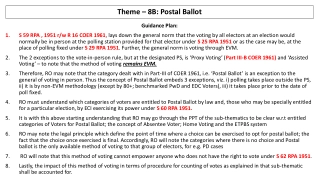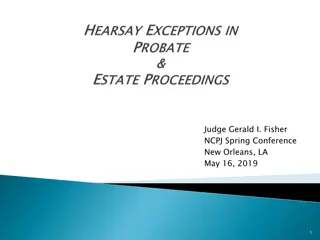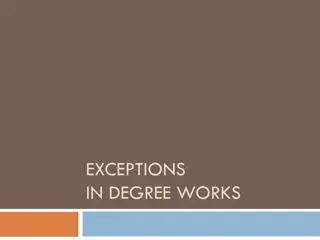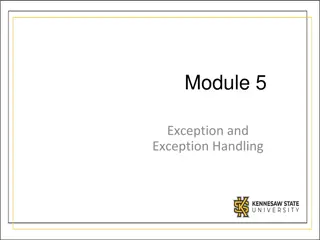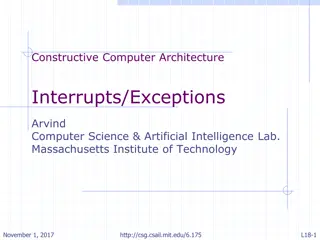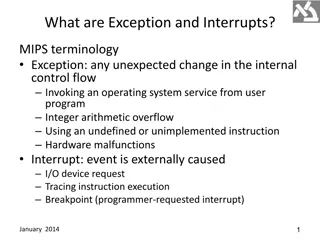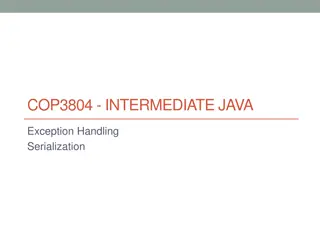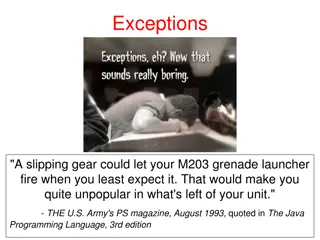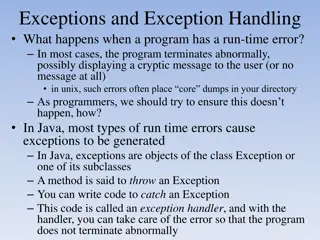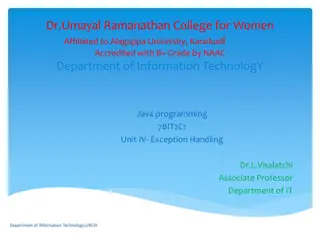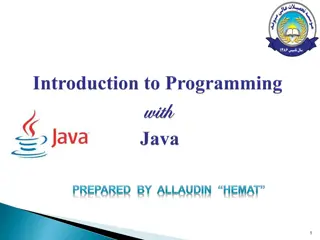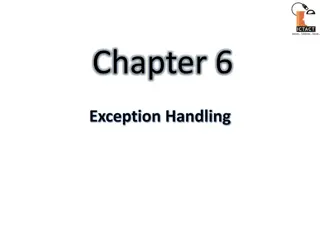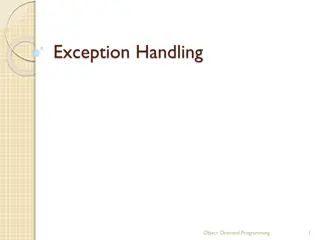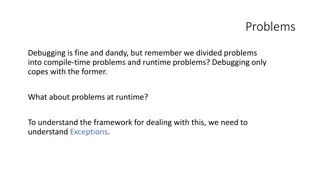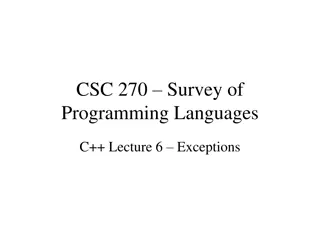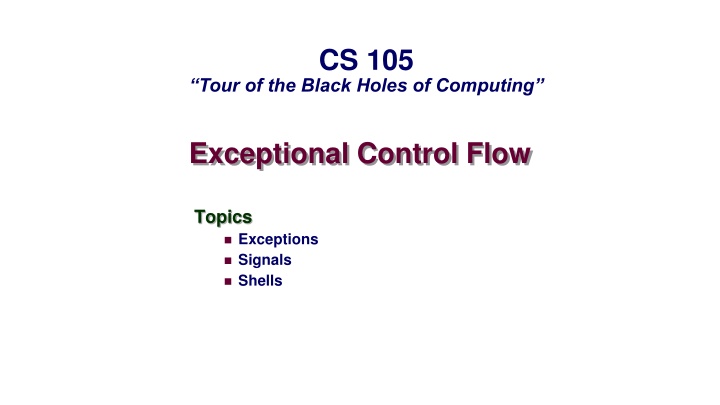
Exceptional Control Flow in Computing Systems
Explore the black holes of computing with a focus on exceptional control flow topics such as exceptions, signals, and shells. Join ACM for cutting-edge research and benefits. Learn about altering control flow, dealing with I/O problems, handling errors, and more. Exceptional control flow exists at all levels of a computer system, with mechanisms for handling changes in control flow.
Download Presentation

Please find below an Image/Link to download the presentation.
The content on the website is provided AS IS for your information and personal use only. It may not be sold, licensed, or shared on other websites without obtaining consent from the author. If you encounter any issues during the download, it is possible that the publisher has removed the file from their server.
You are allowed to download the files provided on this website for personal or commercial use, subject to the condition that they are used lawfully. All files are the property of their respective owners.
The content on the website is provided AS IS for your information and personal use only. It may not be sold, licensed, or shared on other websites without obtaining consent from the author.
E N D
Presentation Transcript
CS 105 Tour of the Black Holes of Computing Exceptional Control Flow Topics Exceptions Signals Shells
Join the ACM for Free! World s most important society for computer scientists Publishes cutting-edge research Many, many benefits Just visit https://www.acm.org/studentjoin It s easy and free! CS 105 2
Control Flow Computers do only one thing From startup to shutdown, a CPU core simply reads and executes (interprets) a sequence of instructions, one at a time This sequence is the system s physical control flow (or flow of control) Physical control flow <startup> inst1 inst2 inst3 instn <shutdown> Time CS 105 3
Altering the Control Flow Up to now: two mechanisms for changing control flow: Jumps and branches react to changes in program state Call and return using stack discipline react to program state Insufficient for a useful system Difficult for the CPU to react to other unexpected changes in system state Data arrives from a disk or a network adapter Instruction divides by zero User hits control-C at the keyboard System timer expires System needs mechanisms for exceptional control flow CS 105 4
Dealing With I/O Problem: I/O devices are slow Solution 1: wait for I/O CPU stops executing instructions until device gives answer Solution 2: polling Keep computing something else while I/O is happening Every so often, check to see whether I/O is done Solution 3: interrupts Keep computing something else while I/O is happening Device eventually interrupts CPU to tell it I/O is done CS 105 5
Dealing With Errors How to handle bad mistakes like divide by 0? Solution 1: ignore completely Solution 2: set a flag and let program check Used for minor errors like integer overflow Nuisance to check after every important operation (e.g., division) Solution 3: interrupts Let CPU notify program in a special way when bad things happen Mechanism can be (nearly) identical to that used for I/O CS 105 6
Exceptional Control Flow Exists at all levels of a computer system Low-Level Mechanism Exceptions Change in control flow in response to a system event (i.e., change in system state) Combination of hardware and OS software Higher-Level Mechanisms Process context switch (done by OS software and hardware timer) Signals (done by OS software) Nonlocal jumps (throw/catch) ignored in this course CS 105 7
Exceptions An exception is a transfer of control to OS kernel in response to some event (i.e., change in processor state) Exceptions interrupt the normal control flow User Process OS Exception current next event Exception processing by exception handler Return to current Return to next Abort & never return Switch to a new process Think of it as a hardware-initiated function call CS 105 8
Exception Tables (Interrupt Vectors) Exception numbers Each type of event has a unique exception number k k = index into exception table (a.k.a., interrupt vector) Jump table entry k points to a function (exception handler). Handler k is called each time exception k occurs. code for exception handler 0 interrupt vector code for exception handler 1 0 1 2 code for exception handler 2 ... ... n-1 code for exception handler n-1 CS 105 9
Asynchronous Exceptions (Interrupts) Caused by events external to processor Indicated by putting voltage on the processor s interrupt pin(s) Handler returns to next instruction. Examples: Timer interrupt Every few milliseconds, triggered by external timer chip Used by kernel to take control back from user programs I/O interrupts Hitting control-C (or any key) at the keyboard Arrival of packet from network Finishing writing data to disk CS 105 10
Synchronous Exceptions Caused by events that occur as result of executing an instruction: Traps Intentional Examples: system calls, breakpoint traps, special instructions Returns control to next instruction Faults Unintentional but possibly recoverable Examples: page faults (recoverable), protection faults (unrecoverable) Either re-executes faulting ( current ) instruction or aborts Aborts Unintentional and unrecoverable Examples: memory error; machine fails ongoing self-tests Aborts current program or entire OS CS 105 11
System Call Example User calls: open(filename, options) Calls __open function, which invokes system call instruction syscall 00000000000e5d70 <__open>: ... e5d79: b8 02 00 00 00 e5d7e: 0f 05 syscall # Return value in %rax e5d80: 48 3d 01 f0 ff ff cmp $0xfffffffffffff001,%rax ... ... e5dfa: c3 retq mov $0x2,%eax # open is syscall #2 User code Kernel code %rax contains syscall number Other arguments in %rdi, %rsi, %rdx, %r10 (weird!), %r8, %r9 Return value will be in %rax Negative value is an error corresponding to negative errno Exception syscall cmp Open file Returns CS 105 14
Fault Example: Invalid Memory Memory Reference User writes to memory location Address is not valid int a[1000]; main () { a[5000] = 13; } 80483b7: c7 05 60 e3 04 08 0d movl $0xd,0x804e360 Virtual memory system detects invalid address, causes fault OS sends SIGSEGV signal to user process (discussed in a few minutes) User process exits with segmentation fault User Process OS page fault event movl Detect invalid address Signal process CS 105 16
Killing a Process Problem: runaway process (e.g., unintentional infinite loop) Solution: kernel has superpowers, can kill it off Problem: cleaning up after killing process Kernel can close open files, release memory, etc. Kernel can tknow whether to delete temporary files or send bye-bye message across network Solution: let processes intercept attempt to kill Assumption is that they will clean up and exit gracefully No direct enforcement of that assumption! CS 105 18
Signals A signalis a small message that notifies a process that an event of some type has occurred in the system OS abstraction for exceptions and interrupts Sent from OS kernel (sometimes at request of another process) to a process Different signals are identified by small integer IDs Only information in a signal is its ID and fact of arrival Represented internally by one bit in kernel ID Name Default Action Terminate Terminate Terminate & Dump Terminate Ignore Corresponding Event Interrupt from keyboard (ctl-c) Kill program (cannot override or ignore) Segmentation violation Timer signal Child stopped or terminated 2 SIGINT 9 SIGKILL 11 SIGSEGV 14 SIGALRM 17 SIGCHLD CS 105 19
Signal Concepts: Sending Kernel sends (delivers) a signal to a destination process by updating some state in the context of the destination process Kernel sends a signal for one of the following reasons: Kernel has detected a system event such as divide by zero (SIGFPE) or termination of a child process (SIGCHLD) Another process has invoked the kill system call to explicitly request that the kernel send a signal to the destination process CS 105 20
Signal Concepts: Receiving A destination process receives a signal when it is forced by kernel to react in some way to delivery of the signal Five possible ways to react: Ignore the signal (do nothing) Terminate the process Temporarily stop the process from running Continue a stopped process (let it run again) Catch the signal by executing a user-level function called a signal handler OS-initiated function call Akin to hardware exception handler being called in response to asynchronous interrupt Like interrupts, signal handler might or might not return CS 105 21
Signal Concepts: Pending & Blocked Signals A signal is pending if it has been sent but not yet received There can be at most one pending signal of any particular type Important: signals are not queued If a process has pending signal of type k, then subsequent signals of type k for that process are discarded Process can block receipt of certain signals Blocked signals can be delivered, but won t be received until signal is unblocked Pending signal is received at most once CS 105 22
Receiving Signals Suppose kernel is returning from an exception handler and is ready to pass control to process p Process A Process B user code context switch kernel code Time user code context switch kernel code user code Important: All context switches are initiated by calling some exception handler, e.g. timer or syscall. CS 105 24
Receiving Signals Suppose kernel is returning from an exception handler and is ready to pass control to process p Kernel computes pnb = pending & ~blocked The set of pending nonblocked signals for process p If (pnb == 0) Pass control to next instruction in logical flow for p Else Choose lowest-numbered signal k in pnb, clear corresponding pending bit, and force process p to receive signal k Receipt of signal triggers some action by p Repeat for all nonzero k in pnb Pass control to next instruction in logical flow for p CS 105 25
Sending Signals with kill kill sends arbitrary signal to a process linux> ./forks 16 linux> Child1: pid=24818 Child2: pid=24819 linux> ps PID TTY TIME CMD 24788 pts/2 00:00:00 zsh 24818 pts/2 00:00:02 forks 24819 pts/2 00:00:02 forks 24820 pts/2 00:00:00 ps linux> kill -9 24818 linux> ps PID TTY TIME CMD 24788 pts/2 00:00:00 zsh 24819 pts/2 00:00:03 forks 24823 pts/2 00:00:00 ps linux> Examples kill KILL 24818 Send SIGKILL to process 24818 SIGKILL can t be caught kill 9 24818 Same, for lazy typists CS 105 27
Sending Signals From the Keyboard Typing ctrl-c (ctrl-z) sends a SIGINT (SIGTSTP) the foreground process SIGINT default action is to terminate process SIGTSTP default action is to stop (suspend) process Shell pid=10 Back- ground job #1 Fore- ground job Back- ground job #2 pid=20 pid=32 pid=40 CS 105 29
Sending Signals with kill void fork12() { pid_t pid[N]; int i, child_status; for (i = 0; i < N; i++) if ((pid[i] = fork()) == 0) while(1); /* Child infinite loop (bad style!) */ /* Parent terminates the child processes */ for (i = 0; i < N; i++) { printf("Killing process %d\n", pid[i]); kill(pid[i], SIGINT); } /* Parent reaps terminated children */ for (i = 0; i < N; i++) { pid_t wpid = wait(&child_status); if (WIFEXITED(child_status)) printf("Child %d terminated with exit status %d\n", wpid, WEXITSTATUS(child_status)); else printf("Child %d terminated abnormally\n", wpid); } } CS 105 33
Default Actions Each signal type has predefined default action, which is one of: Process terminates Process terminates and dumps core (memory) to a file Nowadays dump is suppressed in normal operation Was intended for debugging; now usually simpler to rerun under gdb Process stops until restarted by a SIGCONT signal Process ignores the signal CS 105 34
Installing Signal Handlers The sigaction function modifies the default action associated with receipt of signal signum: int *sigaction(int signum, const struct sigaction *act, struct sigaction *oldact) act is a struct with several useful components: sa_mask identifies signals to block while handler runs sa_flags controls certain options sa_handler is special value or address of a signal handler Referred to as installing the handler Called when process receives signal of type signum Executing handler is called catching or handling the signal When handler returns, control passes back to instruction in control flow of process that was interrupted by receipt of the signal Special values for sa_handler: SIG_IGN (ignore signal) or SIG_DFL (return to default) CS 105 36
Signal-Handling Example #include <signal.h> int main() { struct sigaction action, oldaction; /* SIGINT handler */ void sigint_handler(int sig) { printf("So you think you can stop the bomb with ctrl-c, do you?\n"); action.sa_flags = 0; action.sa_handler = sigint_handler; sigemptyset(&action.sa_mask); sigaddset(&action.sa_mask, SIGINT); /* Install the SIGINT handler */ Sigprocmask(SIG_BLOCK, &action.sa_mask, NULL); Sigaction(SIGINT, &action, &oldaction); if (oldaction.sa_handler == SIG_IGN) sigaction(SIGINT, &oldaction, NULL); Sigprocmask(SIG_UNBLOCK, &action.sa_mask, NULL); /* Wait for the receipt of a signal */ pause(); return 0; } sleep(2); printf("Well..."); fflush(stdout); sleep(1); printf("OK. :-)\n"); exit(0); } CS 105 38
Nested Signal Handlers Handlers can be interrupted by other handlers Main program Handler S Handler T (2) Control passes to handler S (1) Program catches signal s Icurr (4) Control passes to handler T (3) Program catches signal t Inext (7) Main program resumes (5) Handler T returns to handler S (6) Handler S returns to main program CS 105 41
Guidelines for Writing Safe Handlers G1: Keep your handlers as simple as possible e.g., Set a global flag and return G2: Call only asynchronous-signal-safe functions in your handlers printf, sprintf, malloc, and exit are not safe! (But _exit is) (We cheated in the example because a screwup would be fairly harmless ) G3: Save and restore errno on entry and exit So that other handlers don t overwrite your value of errno G4: Protect accesses to shared data structures by temporarily blocking all signals. To prevent possible corruption G5: Declare global variables as volatile To prevent compiler from storing them in a register G6: Declare global flags as volatile sig_atomic_t flag: variable that is only read or only written (e.g. flag = 1, not flag++) Flag declared this way does not need to be protected like other globals CS 105 44
Asynchronous-Signal Safety Function is asynchronous-signal-safe if it s either reentrant (e.g., all variables stored on stack frame, CS:APP3e 12.7.2) or non-interruptible by signals. Posix guarantees 117 functions to be async-signal-safe Source: man 7 signal-safety Popular functions on the list: _exit, write, wait, waitpid, sleep, kill Popular functions that are not on the list: printf, sprintf, malloc, exit Unfortunate fact: write is the only asynchronous-signal-safe output function CS 105 45
Shell Programs A shell is an application program that runs programs on behalf of the user sh Original Unix Bourne shell csh BSD Unix C shell, tcsh Enhanced C shell (both deprecated) bash Bourne-Again shell zsh Z shell (default on new CS accounts) int main() { char cmdline[MAXLINE]; while (1) { /* read */ printf("> "); Fgets(cmdline, MAXLINE, stdin); if (feof(stdin)) exit(0); Execution is a sequence of read/evaluate steps } } /* evaluate */ eval(cmdline); CS 105 46
Simple Shell eval Function void eval(char *cmdline) { char *argv[MAXARGS]; /* argv for execvp() */ int bg; /* should the job run in bg or fg? */ pid_t pid; /* process id */ bg = parseline(cmdline, argv); if (!builtin_command(argv)) { if ((pid = Fork()) == 0) { /* child runs user job */ execvp(argv[0], argv); fprintf(stderr, "%s: Command not found.\n", argv[0]); exit(1); } int status; if (waitpid(pid, &status, 0) == -1) unix_error("waitfg: waitpid error"); } else /* otherwise don t wait for bg job */ printf("%d %s", pid, cmdline); } } if (!bg) { /* parent waits for fg job to terminate */ CS 105 47
Problem with Simple Shell Example Shell correctly waits for and reaps foreground jobs But what about background jobs? Will become zombies when they terminate Will never be reaped because shell (typically) will not terminate Eventually you hit process limit and can t do any work ECF to the rescue: SIGCHLD will notify us of child termination Ignored by default, so must explicitly catch But signal handler must be carefully written (see next two slides) CS 105 48
Signal Handler Funkiness int ccount = 0; void child_handler(int sig) { int child_status; pid_t pid = wait(&child_status); ccount--; printf("Received signal %d from process %d\n", sig, pid); } Pending signals are not queued For each signal type, just have single bit indicating whether or not signal is pending Even if multiple processes have sent this signal! void fork14() { pid_t pid[N]; int i, child_status; ccount = N; Signal(SIGCHLD, child_handler); /* Old style */ for (i = 0; i < N; i++) if ((pid[i] = fork()) == 0) { /* Child: Exit */ exit(0); } while (ccount > 0) pause(); /* Suspend until signal occurs */ } CS 105 49
Living With Nonqueuing Signals Must check for all terminated jobs Typically loop with waitpid void child_handler2(int sig) { int child_status; pid_t pid; while ((pid = waitpid(-1, &child_status, WNOHANG)) != -1) { ccount--; printf("Received signal %d from process %d\n", sig, pid); } } void fork15() { . . . signal(SIGCHLD, child_handler2); . . . } CS 105 50
Summary Signals provide process-level exception handling Can generate from user programs Can define effect by declaring signal handler Some caveats Very high overhead >10,000 clock cycles Only use for exceptional conditions Don t have queues Just one bit for each pending signal type CS 105 51


